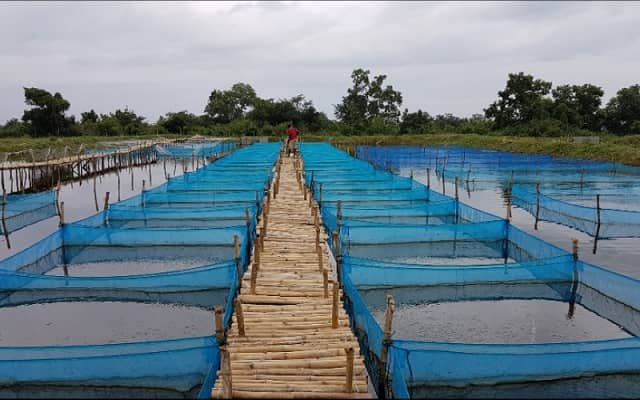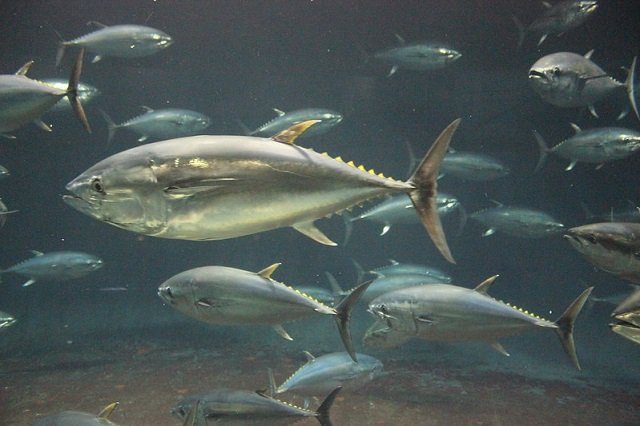USA – Despite aquaculture’s potential to feed a growing world population while relieving pressure on badly depleted oceans, the industry has been plagued by questions about its environmental impacts.
But over the years, the diverse industry – which ranges from massive open-ocean salmon cages to family farm freshwater tilapia ponds – has made significant strides toward sustainability, according to a new Stanford-led analysis.
The study notes, however, that in order for the global aquaculture sector to deliver on its full promise, more effective oversight measures are needed to help ensure that its environmentally sound systems are economically viable.
The findings, published March 25 in Nature, could help shape how consumers think about the seafood they buy, and inform governance strategies critical to global food and nutrition security.
“As the demand for seafood around the world continues to expand, aquaculture will keep growing,” said study lead author Rosamond Naylor, the William Wrigley Professor of Earth System Science in Stanford’s School of Earth, Energy & Environmental Sciences (Stanford Earth). “If we don’t get it right, we risk the same environmental problems we’ve seen in land-based crop and livestock systems: nutrient pollution, excessive use of antibiotics and habitat change that threatens biodiversity.”
Twenty years ago, Naylor led a study that sparked controversy by saying farmed fish and shellfish in some cases added pressure to ocean fisheries – instead of relieving it – because carnivorous farm-raised species required large amounts of wild fish for feed. The paper, also published in Nature, prompted a spate of news stories and academic research questioning whether aquaculture was more of an environmental problem than a solution. Environmental groups applauded the study’s focus on aquaculture’s marine ecosystem impacts, while the industry pointed to hopeful developments that were largely ignored, such as ongoing improvements in fish nutrition.
Since then, the volume of global aquaculture production has tripled. In the new paper, aquaculture specialists and scientists from Asia, Europe, South America and the U.S. assessed the state of the industry by synthesizing hundreds of studies done over the past two decades on issues ranging from value chain developments in freshwater aquaculture to the use of wild fish in feeds to seaweed market challenges.
Stay Always Informed
Join our communities to instantly receive the most important news, reports, and analysis from the aquaculture industry.
Their analysis considered key challenges and uncertainties, such as climate change’s impact on the industry, low-income producers’ adoption of sustainable seafood certification programs and shellfish and seaweed farmers’ ability to profit from providing ecosystem services, such as carbon capture.
Among the findings: freshwater aquaculture, comprised of nearly 150 species of fish, shellfish and plants, accounts for 75% of farmed aquatic food consumed directly by humans.
“Most aquaculture is about fish people can afford to eat – and most of the farming of aquatic animals happening in Asian countries stays in those countries,” said study co-author David Little, a professor in the University of Stirling Institute for Aquaculture, in the U.K. “It’s having an important impact on food security and rural livelihoods.”
Other regions, including Africa, are increasingly benefitting from the introduction of freshwater aquaculture. But while small freshwater farms are on the rise around the world, there is little oversight of their practices.
The researchers also found that the production of high-value shrimp, salmon and other marine fish rose rapidly, contributing to a significant rise in the share of global fishmeal and fish oil used by aquaculture. Yet, the ratio of wild fish input per fed fish output has dropped almost seven-fold since 1997.
“We have been successful in converting carnivorous fish, such as salmon and trout, largely into vegetarians,” said study co-author Ronald Hardy of the Aquaculture Research Institute at the University of Idaho.
In the study, the researchers call for better management of antimicrobial use in fish farming to limit the development of drug-resistant microbes that threaten both fish and human health, and regulation of marine farm sites. They also recommended incentives for sustainably designed systems to prevent cross-contamination between fish waste and surrounding waters, and a food systems approach to governance that considers nutrition, equity, justice and environmental outcomes and trade-offs across land and sea.
“When done well, aquaculture can play a sustaining role in global food systems by providing expanded food production and livelihood benefits with relatively minimal environmental harm,” said study co-author Dane Klinger, director of aquaculture at Conservation International and PhD graduate of Stanford’s Emmett Interdisciplinary Program in Environment and Resources. “This assessment will help industry, government and other stakeholders navigate the opportunities and obstacles that remain ahead.”
The researchers will share observations from their analysis in a related seminar on March 30.
Naylor is also Founding Director of Stanford’s Center on Food Security and the Environment; and a senior fellow in the Stanford Woods Institute for the Environment and the Freeman Spogli Institute for International Studies. Other co-authors of the study include Alejandro Buschmann of the Universidad de Los Lagos (Chile); Simon Bush of Wageningen University (Netherlands); Ling Cao of Shanghai Jiao Tong University (China); Jane Lubchenco of Oregon State University; Sandra Shumway of the University of Connecticut; and Max Troell of the Beijer Institute and Stockholm University (Sweden).
Funding for the research was provided by the Center on Food Security and the Environment, Stanford University.
Contact:
Rosamond Naylor, Stanford School of Earth, Energy & Environmental Sciences: roz@stanford.edu
Rob Jordan, Stanford Woods Institute for the Environment: (650) 721-1881; rjordan@stanford.edu
Reference (open access):
Naylor, R.L., Hardy, R.W., Buschmann, A.H. et al. A 20-year retrospective review of global aquaculture. Nature 591, 551–563 (2021). https://doi.org/10.1038/s41586-021-03308-6
Source: Stanford News
Editor at the digital magazine AquaHoy. He holds a degree in Aquaculture Biology from the National University of Santa (UNS) and a Master’s degree in Science and Innovation Management from the Polytechnic University of Valencia, with postgraduate diplomas in Business Innovation and Innovation Management. He possesses extensive experience in the aquaculture and fisheries sector, having led the Fisheries Innovation Unit of the National Program for Innovation in Fisheries and Aquaculture (PNIPA). He has served as a senior consultant in technology watch, an innovation project formulator and advisor, and a lecturer at UNS. He is a member of the Peruvian College of Biologists and was recognized by the World Aquaculture Society (WAS) in 2016 for his contribution to aquaculture.




